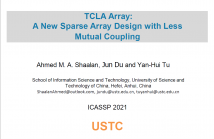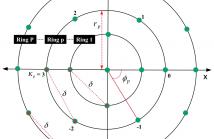
- Read more about A NEW COPRIME-ARRAY-BASED CONFIGURATION WITH AUGMENTED DEGREES OF FREEDOM AND REDUCED MUTUAL COUPLING
- Log in to post comments
In this paper, a new type of coprime-array-based structure, named AtCADiS, is proposed to achieve increased degrees of freedom (DoFs) and reduced mutual coupling. The closed-form expressions for the sensor positions and the number of uniform DoFs (uDoFs) of AtCADiS are provided. Specifically, AtCADiS is constructed via two steps. First, we shift the leftmost sensor of tCADiS to the right by N.
- Categories:
 26 Views
26 Views
- Read more about Semidefinite Relaxation Method for Moving Object Localization Using A Stationary Transmitter at Unknown Position
- Log in to post comments
ICASSP.zip
- Categories:
 9 Views
9 Views
- Read more about Conjugate Augmented Spatial-Temporal Near-Field Sources Localization with Cross Array
- Log in to post comments
- Categories:
 12 Views
12 Views
- Read more about TCLA Array: A New Sparse Array Design with Less Mutual Coupling
- 1 comment
- Log in to post comments
- Categories:
 20 Views
20 Views
- Read more about Single-Point Array Response Control with Minimum Pattern Deviation
- Log in to post comments
- Categories:
 9 Views
9 Views
- Read more about Parameter Identifiability of Spatial-Smoothing-Based Bistatic MIMO Radar
- Log in to post comments
Diversity smoothing has been widely developed for angle estimation with bistatic multiple input multiple output (MIMO) radar in the presence of coherent targets, the parameter identifiability of which is an important issue. In this paper, we are devoted to establishing more accurate conditions by studying the positive definiteness of smoothed target covariance matrix. The antenna numbers of transmit and receive arrays are derived as functions of the target number and target structure. We show that the new results improve upon previous ones and recover them in special cases.
- Categories:
 20 Views
20 Views
We propose a generalized thinned coprime array by introducing the flexible inter-element spacings, where the conventional one can be seen as a special case. We derive closed-form expression for the range of consecutive lags, written as the functions of the antenna numbers and inter-element spacings. We show that, after optimization, the proposed array can achieve more consecutive lags than the other coprime arrays. In particular, the optimized results also provide the minimum number of antenna pairs with small separation.
- Categories:
 15 Views
15 Views
- Read more about LOW-RANK AND SPARSE DECOMPOSITION FOR JOINT DOA ESTIMATION AND CONTAMINATED SENSORS DETECTION WITH SPARSELY CONTAMINATED ARRAYS
- Log in to post comments
Many works have been done in direction-of-arrival (DOA) estimation in the presence of sensor gain and phase uncertainties in the past decades. Most of the existing approaches require either auxiliary sources with exactly known DOAs or perfectly partly calibrated arrays. In this work, we consider sparsely contaminated arrays in which only a few sensors are contaminated by sensor gain and phase errors, and moreover, the number of contaminated sensors as well as their positions are unknown.
- Categories:
 16 Views
16 Views
- Categories:
 27 Views
27 Views
- Categories:
 6 Views
6 Views